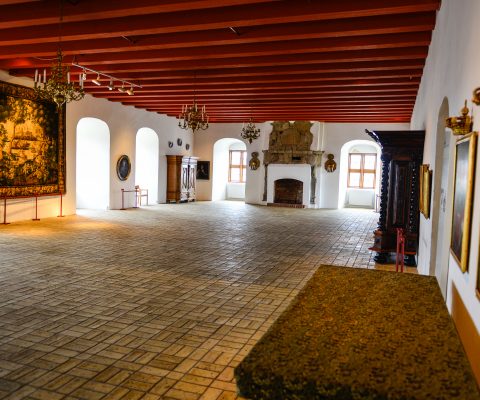The history of the Great Hall
The baronial hall, also known as the Great Hall, was the stately hall used for ceremonial occasions in medieval and Renaissance castles and manor houses. In royal castles, the Great Hall served as the backdrop for official activities such as receiving foreign princes and ambassadors, bestowing fiefdoms, or when the king was presiding over his High Court. When the official duties were over, the hall was converted to a banqueting hall or ballroom.
Koldinghus has had a Great Hall since the Middle Ages – it can be traced to c. 1475, when the west wing was built. The Great Hall probably filled the upper of the two normal floors, and was the place where the king met with his councillors from the kingdom and the duchies.
Around 1600, King Christian IV rebuilt the castle and the Great Hall was moved to the upper floor – the marksmen’s gallery during the medieval period – with the ceiling being raised at the same time. King Christian IV modelled the Great Hall at Koldinghus on that at Kronborg Castle, built by his father. A total of 57 metres long, the Great Hall was the second-longest in Northern Europe, and extended over the castle chapel and along the entire length of the upper floor of the west wing.
In 1616, the Great Hall provided the backdrop when North Schleswig was granted to the Duke of Gottorp. On the same occasion, King Christian IV also established a new order of chivalry, Den væbnede Arm. This order was conferred on a number of noblemen who had distinguished themselves in the Kalmar War against Sweden, but does not appear to have been conferred subsequently. It was also at a masked ball held in the Great Hall in 1711 that King Frederik IV made the acquaintance of Anna Sophie Reventlow, a young lady of noble rank. A year later, the king abducted her from Clausholm, her ancestral home, and entered into a morganatic marriage with her. King Frederik IV and Anna Sophie took marriage vows once more in 1721, this time legitimately, and Anna Sophie thus became Queen of Denmark.
In conjunction with King Frederik IV’s remodelling and modernising of Koldinghus in the years around 1720, the Great Hall disappeared. There was no longer any need for such a large room at Koldinghus, or in any other royal castle outside Copenhagen. With the introduction of absolute monarchy to Denmark in 1660, all official affairs of state had been transferred to Copenhagen.
The Great Hall was thus divided into several rooms. The west wing was remodelled to contain a number of small rooms for the domestic staff attached to the castle and the court. The Great Hall as it is known today was divided into two attics, one for the resident bailiff and the other for the castle matron. When the castle burnt down in 1808, the Great Tower, which to the south was supported by a timber construction built across the Great Hall, partially collapsed and crushed the remainder of the Great Hall and the chapel beneath it.
The west wing was restored during World War I, re-establishing at the same time the partition that King Frederik IV had incorporated as a temporary north gable in the west wing. This now serves as a divider between the Great Hall and the war memorial room. In the 1930s, the Giants’ Tower was rebuilt, with concrete ceilings being constructed above the chapel and Great Hall at the same time.
The Great Hall of today is used by the Danish state, local county and municipality in conjunction with official occasions held at the castle.
 Dansk
Dansk
 English
English
 Deutsch
Deutsch

